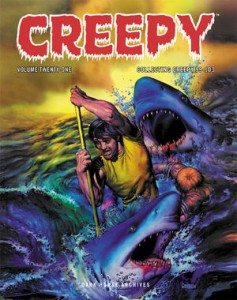
Various authors
Dark Horse Books
February 24, 2015
Reviewed by Tim Potter
Creepy Archives Volume 21 continues Dark Horse Publishing’s excellent series of Warren Comics reprints. This volume, containing the collected issues of Creepy #99-103, brings readers stories originally published in the second half of 1978. The stories are varied and often fascinating as one would expect from the numerous comic book icons who contributed to these stories. The art is presented in striking transfers, and though mainly black and white like the original magazine, this volume also features a few color stories starting with one in issue #100. The color stories here were presented in color in 1978, though not as sharp and clear as the colors in this edition.
This collection is a constant source of entertainment beginning with the collect edition cover, a beautiful full color illustration by comic legend Richard Corben. Paul Tobin, writer of the current Dark Horse horror comic Colder provides a personal introduction to the edition, reflecting back on his personal experiences with horror comics in the 1970s. Five issues follow, each with its own special theme, be it demons or sea stories and monsters. Each issue also has the original “Dear Uncle Creepy” feature that opened each issue and features reader mail commenting on a previous issue. Also reprinted are the one-page editorials titled “The Comic Books” by Joe Brancatell, in which he discusses issues relating to the comic books industry and arts. Especially fascinating is his take on the 1978 Congressional Copyright Act, which greatly changed the relationship between publishers of comics and their creators and continues to be important today.
Issue #99 is billed as the “Earth-Shattering Disasters Issue!”. From nuclear weapons to noise pollution, there are six tales of life ending tragedy. “A Case of Overkill” is a highlight, commenting on the Cold War arms race while telling a science-fiction adventure.
Issue #100 celebrates its anniversary by presenting a full-color story, “Winner Take All”, by Swamp Thing co-creator Len Wein, a tale of high adventure in the tradition of Robert E. Howard. Also in this issue are great stories from writer Bruce Jones, a devilish tale of a she-wolf, and “They’re Going To Be Turning Out the Lights”, an interesting alternate-history take on the (at the time) recent New York City blackout.
Issue #101 is the “Jaws of Death” special issue, capitalizing on the shark-craze started by Peter Benchley’s book and the subsequent movies. In the first story, a two-part tale “In Deep” about a couple lost at sea, Bruce Jones’s main character credits Benchley and the films, within the context of the story. Another color story is featured here, the strangely fantastic “Waterbabies”, with great art with startlingly bright color. The closing story of this issue, “Alternate Paths” features a very Twilight Zone-esque yarn about the dangers of science-gone-wrong and has a deliciously ironic conclusion.
Issue #102 is billed as the “Giant All-Monster Issue” and features monsters of all shape and size. “Pantomime At Sea” is a fun start to the issue about a crew filming a monster movie at sea that goes, inevitably, arwy. One of the real gems of the entire collection, “Killer Claw”, appears in this issue with art by industry legends Walt Simonson and Klaus Jensen. It’s a no-nonsense creature feature with striking visuals. The collection closes with the shortest, and story-wise the weakest, issue.
Issue #103 features only a few stories under the heading “Demon-Beasts Unleashed”. “Bookworm” by veteran writer Gerald (Gerry) Conway gives us characters searching for magic in a vast library of ancient tomes. Also interesting are the witch-scorned-revenge-curse tale “On Little Cat Feet!” and the interesting “Lucky Stiff”.
There are only a few weaknesses with this collected volume, chief among them unfortunate racial content, terms and generalities that were acceptable in 1978 that aren’t acceptable today. The art, luckily few times, also uses some racial caricatures that wouldn’t pass muster today. While these issues can be uncomfortable to read, they are a relic of the time and can serve to show how far issues of race have come in the past decades. The other soft-spot is in the consistency of the stories. While almost all are interesting there are a few stories that just aren’t very good. This is a common, if not ever-present, problem with collections like this, and Creepy Archives Volume 21 is more consistent than most. One other inclusion in the reprints are a real treat: the house advertisements. There is a priceless ad for Creepy and Eerie men’s underwear, tighty-whities briefs with the magazine logos on the front. One wonders just how many pair they managed to sell. From posters of classic monsters to make-up kits and back issues of Creepy and Eerie, the ads really give the reader the feel of holding an original issue of the comic in their hands. Reprinting some of the finest and most interesting comic book material from the late 1970s, Creepy Archives Volume 21 is a great success.








